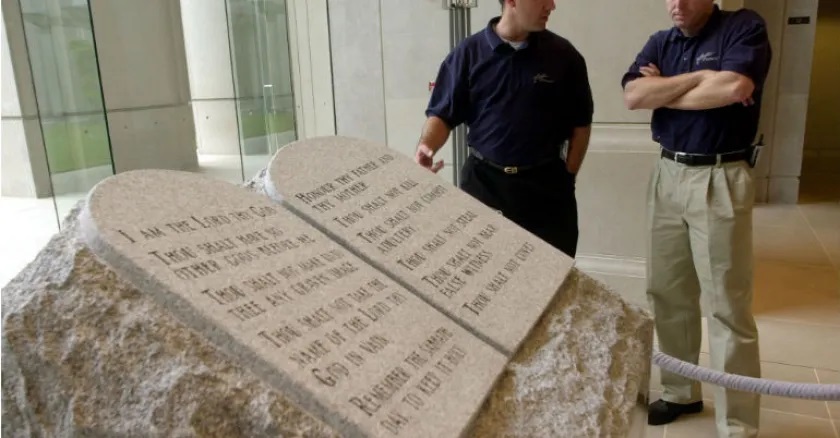![]()

by Jeff Childers
Yesterday’s Lousiana Ten Commandments story grew legs, both in the media and the C&C comments, and starting springing through the public imagination. It was the top story on Google News this morning. Social media was abuzz. God must not enter the classroom! Here’s a sample of yesterday’s hysterical headlines.
CNN:



The New York Times (op-ed by David French):

Amidst the social media firestorm, here came January 6th anti-insurrectionist and revolting Representative Jamie Raskin (D-MD):

Lockdown-loving maskaholic and Teacher’s Union president Randi Weingarten:

And, from our own C&C comments section, here was one thoughtful but passionate example selected at random:

Most C&Cers, like me, recognized the bigger spiritual battle: Restoring God to the classroom displaces evil entities currently roosting there. But recognizing not everyone shares that conviction, and that opinions on this topic are mixed, well-intended, and passionate, I will wade into the controversy just enough to make a few simple, uncontroversial points that should be helpful to both sides and hopefully will elevate the conversation.
Two quick points. First, America was founded as a Judeo-Christian nation. That is a historical fact. It should be undebatable. We can disagree over whether that fact is good or bad (my view, for whatever it’s worth, is that it is an unqualified good). But it is inarguable that, for the Nation’s first 150 years, in full view of the Constitution, during official business, Congress and our Presidents routinely prayed to and recognized the God of the Bible and His Son, Jesus.
Second, also historically, until 1962, when the Supreme Court first ruled school-sponsored prayer unconstitutional in Engel v. Vitale, it was common in many public schools to display the Ten Commandments and incorporate Bible readings or teachings into lessons. Again, this widespread acceptance of Biblical morality occurred during generations of Americans who lived closer in time than we do to the original drafting of the Bill of Rights.
Responding to one of the C&C commenter’s points: the truth is atheists, Muslims and Satanists alike all live in a historically Judeo-Christian country. Good, bad, or indifferent, that is a fact. In the public square, non-Christians may freely worship, without government interference, whatever gods they conceive. They can create their own religious schools and teach their own doctrines in any state in the Union. But they have no claim to any historicity of tolerance for their sacred texts in public schools.
Again, we can argue about normative issues, whether our Nation’s Christian history is good or bad, but the fact remains.
Let us observe another undeniable fact: the Supreme Court’s “separation of Church and State” jurisprudence arose during its renaissance in Constitutional interpretation, when the historically liberal Warren Court discovered the Constitution was a living document moldable by judicial decree. Ten years after banning school prayer, using the same flexible interpretive standards, the same ideological Court under equally flexible Chief Judge Burger would surprise the world by discovering the penumbral right to abortion hidden deep in the shadows of the Constitution’s living essence
You might accept the left’s argument that striking school prayer was Constitutional progress. But by definition, flexible standards aren’t standards at all. The Court giveth, and the Court taketh away. In 2022, the present originalist Court, in its Dobbs decision, struck down Roe, holding that the 1973 decision was “egregiously wrong from the start” and that its reasoning was “exceptionally weak.”
Again, setting aside the controversial normative questions over the rightness or wrongness of any of these issues, the core argument remains that the Constitution, as originally written, neither guaranteed the right to abortion nor prohibited Christian prayer in public schools.
That is a fact.
In our Constitutional system of government, all powers not expressly granted to the federal government in the Constitution were reserved to the states. Like the Ten Commandments, the Tenth Amendment is simple and straightforward:
The powers not delegated to the United States by the Constitution, nor prohibited by it to the States, are reserved to the States respectively, or to the people.
Louisiana’s new law requiring posting the Ten Commandments in public schools is better described as a Dobbs-like challenge to the Warren Court’s flexible Constitutional interpretation of the Establishment Clause, which forbids the federal government from establishing any official state religion. Before 1962, it was widely understood that power, the power to establish an official religion, was reserved to the states. After all, the original colonies had been organized around different Christian religious traditions and worried the new federal government would put its then-tiny thumb on the denominational scale.
If you agree with me so far, then the debate isn’t truly about whether Louisiana’s new law is fair or intolerant. The real debate is over whether changing the Constitution’s original intent about a state’s right to decide its own religious matters requires a Constitutional Amendment rather than another new Supreme Court decision. But here we are.

